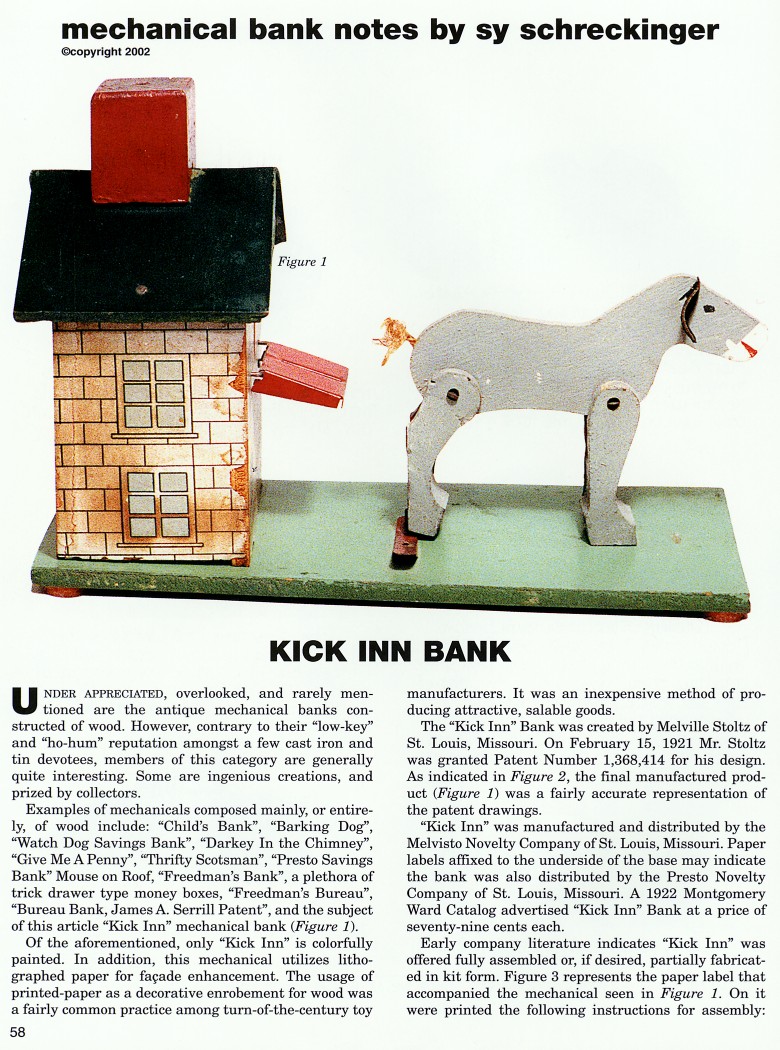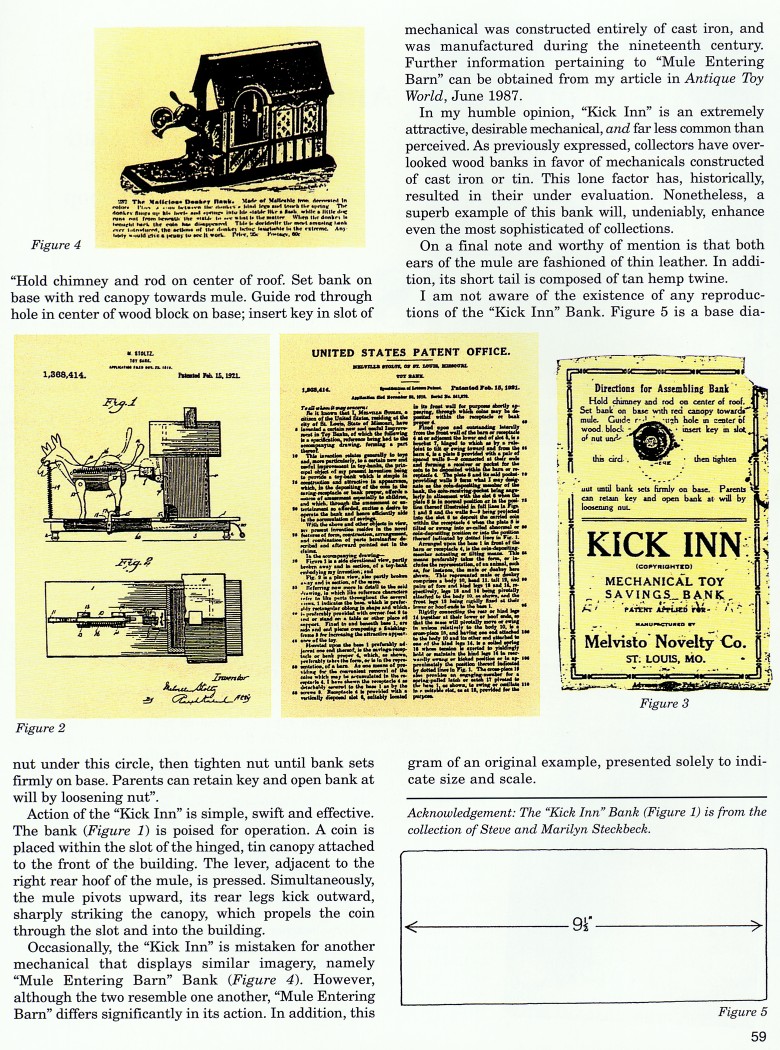|
Kick Inn Bank
by Sy Schreckinger – ANTIQUE TOY WORLD Magazine – March, 2002
Under
appreciated, overlooked, and rarely mentioned are the antique mechanical
banks constructed of wood. However, contrary to their "low-key" and
"ho-hum" reputation amongst a few cast iron and tin devotees, members of
this category are generally quite interesting. Some are ingenious
creations, and prized by collectors.
Examples of mechanicals composed mainly, or entirely, of wood
include: "Child's Bank", "Barking Dog", "Watch Dog Savings Bank", "Darkey
In the Chimney", "Give Me A Penny", "Thrifty Scotsman", "Presto Savings
Bank" Mouse on Roof, "Freedman's Bank", a plethora of trick drawer type
money boxes, "Freedman's Bureau", "Bureau Bank, James A. Serrill Patent",
and the subject of this article "Kick Inn" mechanical bank (Figure 1).
Of the aforementioned, only "Kick Inn" is colorfully painted. In
addition, this mechanical utilizes lithographed paper for facade
enhancement. The usage of printed-paper as a decorative enrobement for
wood was a fairly common practice among turn-of-the-century toy
manufacturers. It was an inexpensive method of producing attractive,
salable goods.
The "Kick Inn" Bank was created by Melville Stoltz of St. Louis,
Missouri. On February 15, 1921 Mr. Stoltz was granted Patent Number
1,368,414 for his design. As indicated in Figure 2, the final manufactured
product (Figure 1) was a fairly accurate representation of the patent
drawings.
"Kick Inn" was manufactured and distributed by the Melvisto Novelty
Company of St. Louis, Missouri. Paper labels affixed to the underside of
the base may indicate the bank was also distributed by the Presto Novelty
Company of St. Louis, Missouri. A 1922 Montgomery Ward Catalog advertised
"Kick Inn" Bank at a price of seventy-nine cents each.
Early company literature indicates "Kick Inn" was offered fully
assembled or, if desired, partially fabricated in kit form. Figure 3
represents the paper label that accompanied the mechanical seen in Figure
1. On it were printed the following instructions for assembly: "Hold
chimney and rod on center of roof. Set bank on base with red canopy
towards mule. Guide rod through hole in center of wood block on base;
insert key in slot of nut under this circle, then tighten nut until bank
sets firmly on base. Parents can retain key and open bank at will by
loosening nut".
Action of the "Kick Inn" is simple, swift and effective. The bank
(Figure 1) is poised for operation. A coin is placed within the slot of
the hinged, tin canopy attached to the front of the building. The lever,
adjacent to the right rear hoof of the mule, is pressed. Simultaneously,
the mule pivots upward, its rear legs kick outward, sharply striking the
canopy, which propels the coin through the slot and into the building.
Occasionally, the "Kick Inn" is mistaken for another mechanical that
displays similar imagery, namely "Mule Entering Barn" Bank (Figure 4).
However, although the two resemble one another, "Mule Entering Barn"
differs significantly in its action. In addition, this mechanical was
constructed entirely of cast iron, and was manufactured during the
nineteenth century. Further information pertaining to "Mule Entering Barn"
can be obtained from my article in Antique Toy World,
June 1987.
In my humble opinion, "Kick Inn" is an extremely attractive,
desirable mechanical, and far less common than perceived. As previously
expressed, collectors have overlooked wood banks in favor of mechanicals
constructed of cast iron or tin. This lone factor has, historically,
resulted in their under evaluation. Nonetheless, a superb example of this
bank will, undeniably, enhance even the most sophisticated of collections.
On a final note and worthy of mention is that both ears of the mule
are fashioned of thin leather. In addition, its short tail is composed of
tan hemp twine.
I am not aware of the existence of any reproductions of
the "Kick Inn" Bank. Figure 5 is a base diagram of an original example,
presented solely to indicate size and scale.
Acknowledgement: The "Kick Inn" Bank (Figure 1) is from the
collection of Steve and Marilyn Steckbeck.
|


